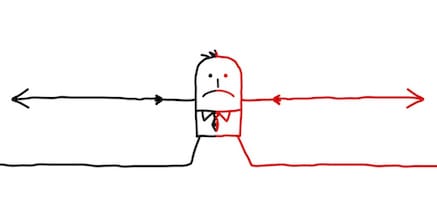Whenever we experience a conflict, it can be difficult to figure out how to move forward. On the one hand, it is never right to mindlessly suppress what you think is “emotion” and go by “reason.” On the other hand, it is never right to mindlessly go by “emotion” and ignore “reason.”
I put them both in scare quotes because if you are making a knee-jerk reaction, it is mindless and neither side is “reason.” You simply don’t have a considered judgment. And that gives us the key to how to move forward in the face of conflict. We have to stop being mindless!
The first thing to do in the face of conflict is always to translate the emotions into the ideas they are based on. That alone may help you resolve the conflict. Even if the conflict remains, however, translating the emotions into ideas will allow you to make a considered judgment about how to move forward.
If you have introspected and you still are in conflict, you are facing some kind of conflict between “I want” and “I should.” For an egoist, these two values logically ought to be in alignment; if they aren’t, there’s something missing in the reasoning, and you really don’t know which is the best choice. You don’t know where the hole in the reasoning is.
What should you do? I believe there are four rational options:
a) Delay action until the conflict is resolved, accepting the penalty of delay.
b) Suppress the “want” and go by “should,” committing to further introspection of “want” later.
c) Go by “want,” accepting the predictable consequences of violating a “should” and committing to further work to understand the “want” and eventually reconcile it.
d) Take an emotionally tolerable step toward “should” (without suppressing) and introspect further (with the hope the new information gained thereby may resolve the conflict).
Each of these options has pros and cons — and that is what makes it so difficult to choose among them. They all involve the principle of “take what you want and pay for it.” You get the positive, and take the hit — the penalty — that you also predict. This is what makes each of these a rational choice. You are acting with your eyes open.
But that doesn’t make it easy to choose which path to follow. You can readily judge the biggest positive among positives and the least negative among negatives. But mix the positives and negatives and your subconscious cannot sum up the issue and make a judgment.
Here’s one process for choosing that I learned from PJ Eby. You start by dealing with the negatives — making sure they are all tolerable by mitigating them if necessary. Then you reframe each negative as a positive. The result is that you make sure all the choices are tolerable and then you choose the biggest positive. That’s the pro-value, motivation-by-love approach to moving forward in the face of conflict.
For example, suppose you are a manager conflicted about firing an employee.
Suppose you see no benefit to proceeding before you are clear and a big payoff in resolving the conflict and making the best call. Then you should delay.
Or suppose if you don’t fire the person immediately, you expect the division’s profits will be hit. If you feel you need to act urgently, you may choose to suppress and mitigate that negative by scheduling a time to deal with the ambivalent feelings later.
Or suppose when you think about the confrontation involved in firing, you start shaking uncontrollably — and you are willing to take the hit of poor work while you introspect your own emotional issues. Then you might consciously choose to document the problem rather than fire him even if you think you probably should let him go.
Or suppose you want to gather more information before making a decision. You might plan a small step — like discussing the problem with the employee even if that might be uncomfortable — to help you choose between whether to fire him or just document the problem.
The decision will be based on the values at stake, including emotional values. For example, a panic attack is a disvalue; if your psychology is such that you would have a panic attack with one of the options, that is a negative that does influence the decision. An option that moves you in the same direction, with less personal disruption, would likely be much better.
The idea is that with the right strategy and some creativity, you can come up with a number of rational, tolerable options, then choose the one that you like the best. Once you have a number of rational alternatives (rational given your uncertainty), it is entirely appropriate to choose the one that seems most appealing.









0 Comments